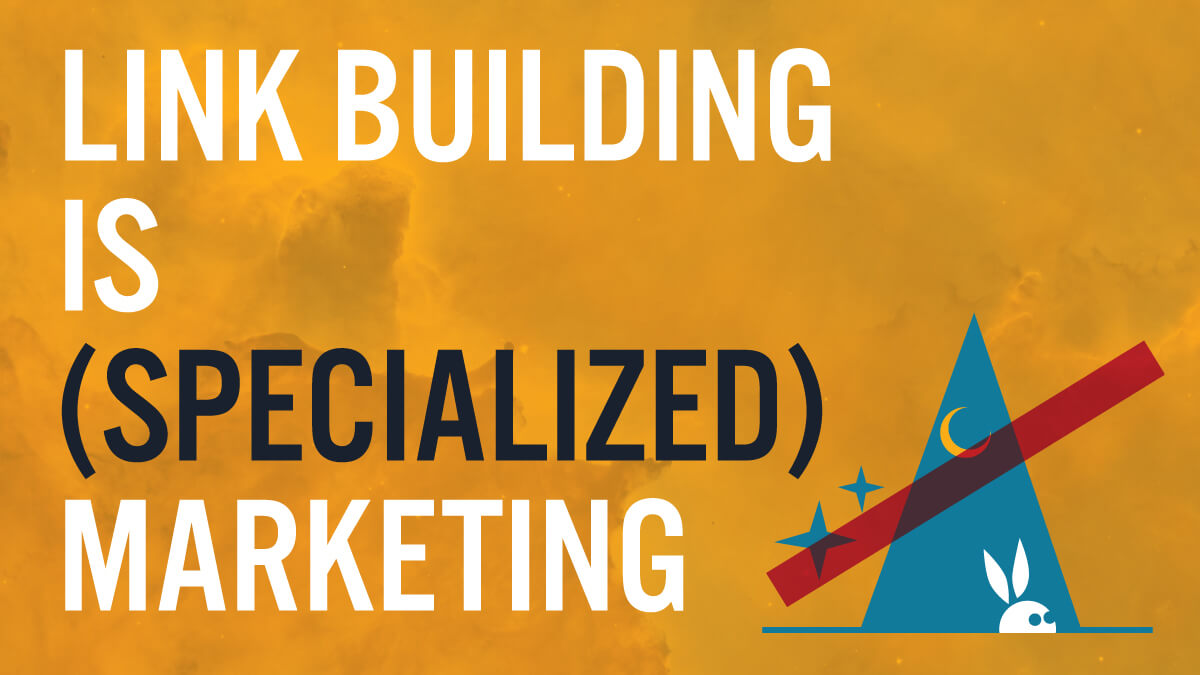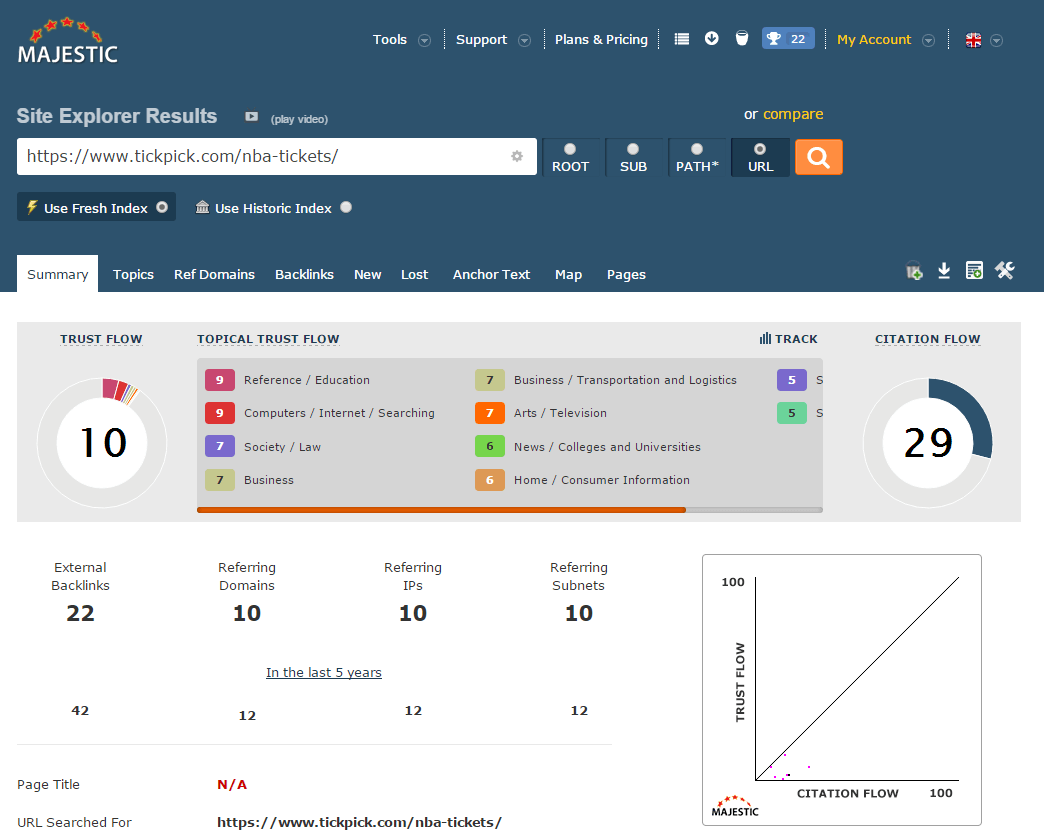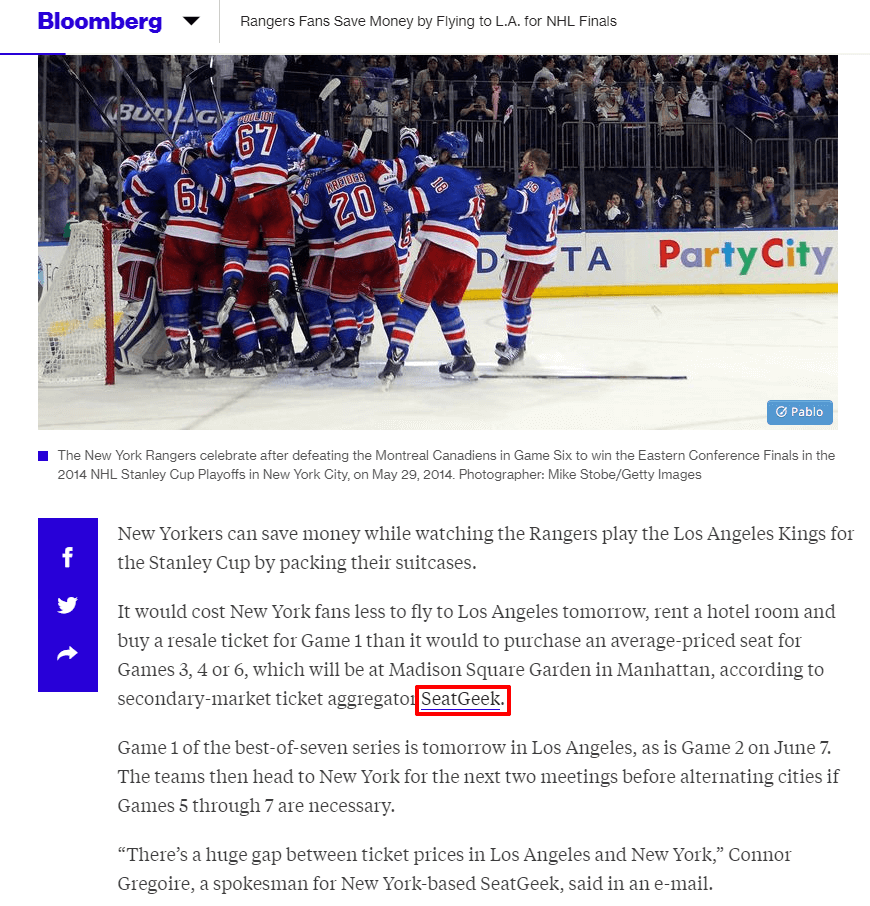Link building is (specialized) marketing

The principles that apply to good marketing are the same principles that apply to good link building. The process to secure links might be unique, but the guiding philosophy should be grounded in traditional marketing.
Some think that link building is a magic bullet for SEO, or some sort of “traffic faucet” they can turn on and off as needed. In reality, link building is the manual promotion of an asset to a targeted audience — also known as marketing.
The same fundamental philosophies that drive effective marketing drive effective link building:
- Audience development: Research which sites, communities and online platforms are popular with your audience in order to know where to secure links.
- Niche research: Analyze linking environment and current market position to strategically pursue links.
- Competitive analysis: Evaluate competitor backlinks and strategies to set expectations and achieve results.
- Targeted promotion: Find relevant and valuable opportunities to effectively secure links.
- Compelling messaging: Communicate the value of linking via outreach.
- Consistent effort: Create a sustained campaign that achieves lasting results.
Thorough research, strategic promotion, carefully crafted messaging and sustained effort are the foundations for success — in marketing and link building alike.
Link building isn’t some mystical SEO hack. It’s just fundamentally good marketing with a unique twist: instead of converting a customer, you’re trying to earn a link.
Today I want to demonstrate how the process of building links aligns with sound marketing principles. To ground this post in reality, I will use TickPick, a ticket vendor site (not a client), as a running example throughout. For the purpose of my example, we’ll say TickPick’s goal is to improve organic traffic to their NBA tickets page.
Audience development guides link acquisition
The process of building good links requires audience development, just as in core marketing principles. You’ll need a deep understanding of your audience before you can effectively promote your content, website and brand for links.
Audience development in link building starts with link prospecting — the act of finding sites and online communities that are popular with your audience and present opportunities to secure a link. Similar to a PR or ad campaign, link building requires manual research to find where your audience “lives” and the ideal platforms for your messaging (links).
For traditional offline marketing, platforms include:
- television
- radio
- outdoor
- guerrilla marketing
During a link campaign, the platforms are the websites themselves. They could include:
- blogs
- online magazines
- forums
- social communities
- directories
- media/government/educational/commercial sites
The links that really move the needle and stand the test of time are those that help your brand tap into relevant audiences, which requires an understanding of your audience and where they live online.
Finding the influencers in your niche is also important in acquiring links. Tools like BuzzSumo and BuzzStream Discovery have various processes and functions that can help SEOs find the influential people in their niche. Influencers can assist promotion, lend credibility to your assets/website and open the doors to new relationships and partnerships (which has benefits beyond links).
For audience discovery, BuzzStream Discovery helps to quickly find the influential authors in the NBA niche:

And right off the bat, I have three authors who write about NBA basketball that I can begin building relationships with to bolster my promotion efforts. Of course, this is only the tip of the iceberg (the first three results in BuzzStream Discovery), and there are many more potential influencers to research.
Building positive connections like these helps:
- secure link opportunities on high-profile sites.
- develop brand advocates for further message dissemination.
- amplify promotional efforts via social media.
- grow brand reputation and trust through endorsements.
- increase your network to make even more influential connections.
Every relationship you build might not earn a link, but relationship building is as much a part of link building as it is any other marketing strategy.
Niche research is necessary to understand the linking environment
Real link building requires niche research.
SEOs need to understand their current position in the market, identify opportunities for growth or improvement, and analyze potential tactics to develop a sustainable plan for earning links.
To secure meaningful links, SEOs must:
- be aware of industry relationships and partnerships.
- understand how sites link and why (linking environment).
- recognize market position and key differentiators (USPs) for their brand.
- know which social platforms are the most popular with their audience.
- understand which types of content earns links.
Websites in different niches link in different ways and with varying frequency. Link-building experience and continual analysis give SEOs a firm understanding of the linking environment in a given niche, but initial research is critical to establishing a foundation for a successful campaign.
For quick and dirty analysis at the beginning of a project, SEOs analyze the backlinks of the top-ranking content in the search results. Links are one of the top two signals in Google’s search algorithm, so it’s safe to assume that the links pointing to the top results are a big reason those pages are ranking.
Tools such as Majestic, Open Site Explorer and Ahrefs are made for backlink analysis, and they can reveal:
- common sites that link to similar content regularly.
- popular forms of linking: editorial citation, informational reference, directory listing, resource endorsement and so on.
- the composition of a strong backlink profile.
- volume and authority of links needed to rank competitively.
- effective strategies for securing links.
For the example of TickPick, I would analyze the search results for “NBA basketball tickets.”

Wow. There are a lot of ads there, and I’m willing to guess that’s an expensive PPC phrase. But we’re focused on organic in this post, so I want to see what it might take to rank on this page organically.
Using Majestic, I can examine the backlinks of each page that is ranking in page one of the SERPs, and then get an idea of what it might take to rank there.
With Majestic, I find the average number of linking root domains for these pages is ~300, and the average Trust Flow is ~34. This tells me that these are established, authoritative domains, and it will be difficult for TickPick to break into the first page for this search.
However, it wouldn’t be impossible. For example, compare Cheap Tickets’ NBA page…

… to TickPick’s:

These two pages have similar characteristics in referring domains and Trust Flow. Of course, Cheap Tickets outperforms TickPick on a domain level by a wide margin (Trust Flow of 69 vs. 14), which is the difference-maker. But there’s reason to believe that a sustained, strategic link campaign over time could make TickPick competitive for page one of this result.
The key would be to temper expectations, and to understand that this is the “pie in the sky” goal, that it will take time and hard work to achieve, and that there are no guarantees.
Quick analysis of a handful of important keywords and phrases will provide initial direction at the start of a link campaign and assist overarching strategy development.
Securing real links that lead to real results requires an overarching strategy which, like any marketing campaign, will require market research.
Competitive analysis informs link strategy
A successful marketing initiative includes competitive analysis, and so does link acquisition.
Competitive analysis empowers a sustainable link campaign — and I don’t mean simply copying the links of your competitors.
Proper analysis uncovers:
- the types of pages that perform well in search.
- competitor strategies and tactics.
- competition level for various keywords and phrases.
- average number of linking root domains among competitors.
- top-performing competitors in search.
- hidden or unknown search competitors.
- content opportunities and gaps.
- competitor partnerships and relationships.
Planning a print advertising campaign requires you take into account the competition — how much they’re spending, where they’re placing ads, the messaging of their ads and so on. Link campaigns are no different; ongoing competitive analysis guides decision-making and strategy.
If SEOs want to succeed in search (and link building), they need to understand what is and isn’t working for the competition.
Using my TickPick example, I did some quick analysis on their competitor, SeatGeek. Using Majestic to look at how SeatGeek is securing some of their best links, I noticed a couple of high-authority in-content citations.

One on Bloomberg:

And a link on NBC News:

Both of these links are citations to SeatGeek for their unique industry research. This is an intelligent strategy that has earned some high-profile links, and it should be considered for TickPick.
Of course, these are only two links discovered in a cursory look at SeatGeek’s backlinks. If I were managing a campaign for TickPick, I would research this tactic further and evaluate the ROI (links versus time spent generating data) before pursuing a full-scale strategy.
Research is a fundamental part of quality link building and marketing alike.
Strategic promotion is required to secure links
Manual link acquisition is the strategic, targeted promotion of a web page to a relevant site with the primary goal of securing a link.
If you boil that down to its purest form, you get “targeted promotion to a relevant audience.” This is why link building, at its core, is specialized marketing. Link building shares the same high-level goals, philosophies and challenges as PR and advertising.
A strategic, targeted approach to link building is required for SEOs to secure worthwhile links that stand the test of time.
The internet is a noisy, crowded space, and as with television advertising, SEOs must be hyper-focused to ensure their marketing stands out. In link building, this means finding the most relevant link prospects to target.
A classic approach SEOs use to find relevant websites is advanced search modifiers in Google. These modifiers allow SEOs to be more granular and targeted with searches, weeding out irrelevant results and finding the right platforms to tap into their audience online.
Just as you would use demographics to determine where to buy ad placements, SEOs consider demographics during link prospecting.
For TickPick, I could use a search string like “intitle:NBA resources inurl:tickets” to find pages that discuss NBA tickets. Here is what that SERP looks like, and I already see a relevant prospect:

This article on Bizjorunals.com represents a potential relevant link opportunity, particularly because it mentions TickPick.

A relevance-first mindset will guide SEOs to the right sites and links for their audience.
However, relevance isn’t always easily identifiable — measuring relevance takes critical thinking.
But relevance isn’t the only factor considered when evaluating potential link opportunities. Being strategic means analyzing an amalgamation of factors before pursuing a link prospect, ensuring a link there will serve your campaign’s goals.
Similar to ad placements, link placements must be targeted to have the most impact.
Messaging can be the difference between success or failure
Like any marketing initiative, successful link building is predicated on carefully crafted messaging.
The ultimate goal of any marketing message is to communicate value (of a brand, business, product and so on) in a compelling way to prompt action (purchase, pique interest, discuss). Link acquisition focuses on communicating the value of your website to other sites, in order to secure a link.
Messaging within link building comes in during outreach, which is the persuasive communication used to convince other sites to link. Online, this typically means email. Because you’re battling full inboxes, spam folders, lack of face-to-face interaction and so forth, you must be more attentive and deliberate in your communication.
If we go back to the Bizjournals article in my last example, I’ll demonstrate a thoughtful outreach message.
SEOs need to be diligent in who they contact. Because this is an article, I want to contact the author directly. The author is Jody Meacham, and if I click on his profile, I can find his email.

My email would be succinct and aim to communicate, clearly and persuasively, the value of adding my link to his article.
Here is an example of the email I would use:
Hello Jody,
I found your article about secondhand Warriors tickets on Bizjournals and noticed you cited TickPick within the post.
We appreciate the mention! I work with TickPick, and I’m emailing to see if you could add a link to TickPick. A link would be relevant and useful to your readers who wanted to learn more about our site, and the data cited.
Thanks so much for mentioning TickPick, and I look forward to hearing from you.
Best,
Andrew Dennis
There are a number of best practices SEOs follow to improve outreach, but in the end whether or not we get the link comes down to messaging and thoughtfully communicating value. Of course, having a best-in-class asset/page (like a best-in-class product) will only make our messaging that much more compelling.
Often the success of a marketing campaign comes down to messaging. This is true as well in link building, where effective outreach is the difference between success and failure.
Sustainable campaigns need consistent effort
Consistency is the mark of good marketing.
Consistent branding, messaging, values, service and so forth all build customer loyalty and trust over time. In link building and SEO, consistent and sustained effort is the only way to achieve long-lasting results.
Similar to advertising, link campaigns are an investment into visibility, branding and exposure; if you’re not investing, you’re falling behind the competition.
On a macro level, consistent link building effort means a sustained campaign with long-term vision, building momentum year over year. On a micro level, this effort is represented by the day in, day out work “in the trenches” to find new prospects and follow up as necessary until a link is earned.
Link acquisition isn’t a magic bullet or stop-gap solution for organic search. There is no hypodermic needle in any marketing. The only way to achieve consistent performance in organic search is through sound technical SEO and sustainable link building.
Opinions expressed in this article are those of the guest author and not necessarily Search Engine Land. Staff authors are listed here.
New on Search Engine Land





:max_bytes(150000):strip_icc()/GettyImages-559025517-2000-b3bece30a9074ec3958a4d39f69f2a79.jpg)
